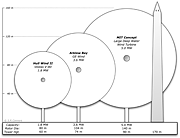Giant wind turbines, floating out of sight
According to their analyses, the floater-mounted turbines could work in water depths ranging from 30 to 200 meters. In the Northeast, for example, they could be 50 to 150 kilometers from shore. And the turbine atop each platform could be big—an economic advantage in the wind-farm business. The MIT-NREL design assumes a 5.0 megawatt (MW) experimental turbine now being developed by industry. (Onshore units are 1.5 MW, conventional offshore units, 3.6 MW.)
Stable enough for towing
Ocean assembly of the floating turbines would be prohibitively expensive because of their size: the wind tower is fully 90 meters tall, the rotors about 140 meters in diameter. So the researchers designed them to be assembled onshore—probably at a shipyard—and towed out to sea by a tugboat. To keep each platform stable, cylinders inside it are ballasted with concrete and water. Once on site, the platform is hooked to previously installed tethers. Water is pumped out of the cylinders until the entire assembly lifts up in the water, pulling the tethers taut.
The tethers allow the floating platforms to move from side to side but not up and down—a remarkably stable arrangement. According to computer simulations, in hurricane conditions the floating platforms—each about 30 meters in diameter—would shift by one to two meters, and the bottom of the turbine blades would remain well above the peak of even the highest wave. The researchers are hoping to reduce the sideways motion still further by installing specially designed dampers similar to those used to steady the sway of skyscrapers during high winds and earthquakes.


